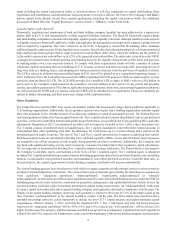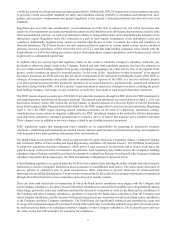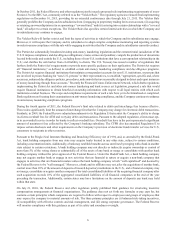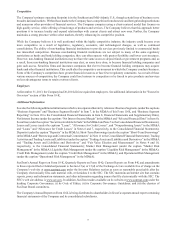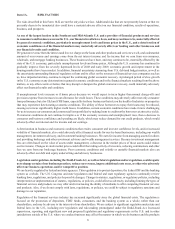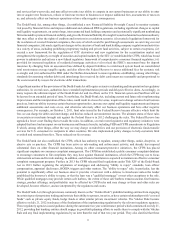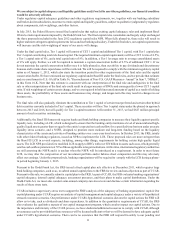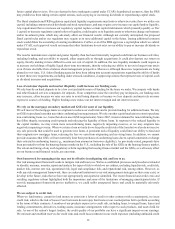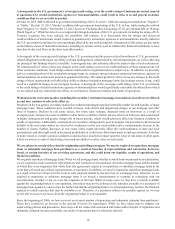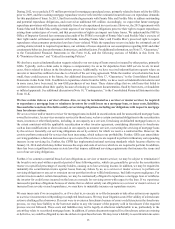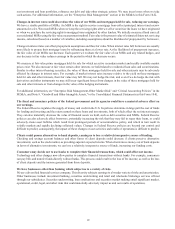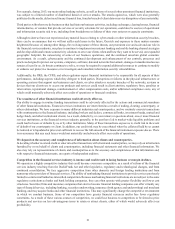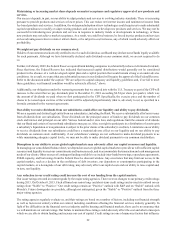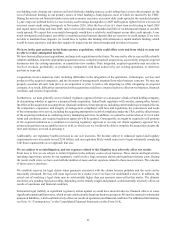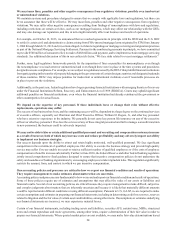SunTrust 2013 Annual Report Download - page 30
Download and view the complete annual report
Please find page 30 of the 2013 SunTrust annual report below. You can navigate through the pages in the report by either clicking on the pages listed below, or by using the keyword search tool below to find specific information within the annual report.14
A downgrade in the U.S. government's sovereign credit rating, or in the credit ratings of instruments issued, insured
or guaranteed by related institutions, agencies or instrumentalities, could result in risks to us and general economic
conditions that we are not able to predict.
On June 10, 2013, S&P reaffirmed its government bond rating of the U.S. at AA+, while also raising its outlook from “Negative”
to “Stable.” On July 18, 2013, Moody’s reaffirmed the government bond rating of the U.S. at Aaa, while raising the outlook
from “Negative” to “Stable.” On October 15, 2013, however, Fitch placed its AAA rating of U.S. government debt on “Ratings
Watch Negative.” While the risk of a sovereign credit ratings downgrade of the U.S. government, including the rating of U.S.
Treasury securities, has been reduced, the possibility still remains. It is foreseeable that the ratings and perceived
creditworthiness of instruments issued, insured or guaranteed by institutions, agencies or instrumentalities directly linked to
the U.S. government could also be correspondingly affected by any such downgrade. Instruments of this nature are key assets
on the balance sheets of financial institutions, including us, and are widely used as collateral by financial institutions to meet
their day-to-day cash flows in the short-term debt market.
A downgrade of the sovereign credit ratings of the U.S. government and the perceived creditworthiness of U.S. government-
related obligations could impact our ability to obtain funding that is collateralized by affected instruments, as well as affecting
the pricing of that funding when it is available. A downgrade may also adversely affect the market value of such instruments.
We cannot predict if, when or how any changes to the credit ratings or perceived creditworthiness of these organizations will
affect economic conditions. Such ratings actions could result in a significant adverse impact on us. In addition, we presently
deliver a material portion of the residential mortgage loans we originate into government-sponsored institutions, agencies or
instrumentalities (or instruments insured or guaranteed thereby). We cannot predict if, when or how any changes to the credit
ratings of these organizations will affect their ability to finance residential mortgage loans. Such ratings actions, if any, could
result in a significant change to our mortgage business. A downgrade of the sovereign credit ratings of the U.S. government
or the credit ratings of related institutions, agencies or instrumentalities would significantly exacerbate the other risks to which
we are subject and any related adverse effects on our business, financial condition and results of operations.
Weakness in the real estate market, including the secondary residential mortgage loan markets, has adversely affected
us and may continue to adversely affect us.
Weakness in the non-agency secondary market for residential mortgage loans has limited the market for and liquidity of many
mortgage loans. These conditions have resulted in losses, write-downs and impairment charges in our mortgage and other
lines of business. Declines in real estate values, low home sales volumes, financial stress on borrowers as a result of
unemployment, interest rate resets on ARMs or other factors could have further adverse effects on borrowers that could result
in higher delinquencies and greater charge-offs in future periods, which would adversely affect our financial condition or
results of operations. Additionally, counterparties to insurance arrangements used to mitigate risk associated with increased
defaults in the real estate market are stressed by weaknesses in the real estate market and a commensurate increase in the
number of claims. Further, decreases in real estate values might adversely affect the creditworthiness of state and local
governments, and this might result in decreased profitability or credit losses from loans made to such governments. A decline
in home values or overall economic weakness could also have an adverse impact upon the value of real estate or other assets
which we own as a result of foreclosing a loan and our ability to realize value on such assets.
We are subject to certain risks related to originating and selling mortgages. We may be required to repurchase mortgage
loans or indemnify mortgage loan purchasers as a result of breaches of representations and warranties, borrower
fraud, or certain breaches of our servicing agreements, and this could harm our liquidity, results of operations, and
financial condition.
We originate and often sell mortgage loans. When we sell mortgage loans, whether as whole loans or pursuant to a securitization,
we are required to make customary representations and warranties to the purchaser about the mortgage loans and the manner
in which they were originated. Our whole loan sale agreements require us to repurchase or substitute mortgage loans in the
event that we breach any of these representations or warranties. In addition, we may be required to repurchase mortgage loans
as a result of borrower fraud or in the event of early payment default by the borrower on a mortgage loan. Likewise, we are
required to repurchase or substitute mortgage loans if we breach a representation or warranty in connection with our
securitizations, whether or not we were the originator of the loan. While in many cases we may have a remedy available
against the originating broker or correspondent, often these may not be as broad as the remedies available to a purchaser of
mortgage loans against us, and we face the further risk that the originating broker or correspondent may not have the financial
capacity to satisfy remedies that may be available to us. Therefore, if a purchaser enforces its remedies against us, we may
not be able to recover our losses from the originating broker or correspondent.
Since the beginning of 2006, we have received an elevated number of repurchase and indemnity demands from purchasers.
These have resulted in an increase in the amount of losses for repurchases. While we have taken steps to enhance our
underwriting policies and procedures, these steps will not reduce risk associated with loans sold in the past. If repurchase and
indemnity demands increase materially, our results of operations may be adversely affected.


